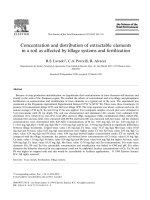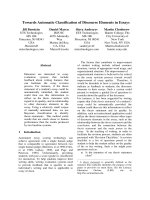Design of Datapath elements in Digital Circuits
Bạn đang xem bản rút gọn của tài liệu. Xem và tải ngay bản đầy đủ của tài liệu tại đây (198 KB, 58 trang )
Design of Datapath elements
in Digital Circuits
Debdeep Mukhopadhyay
IIT Madras
What is datapath?
• Suppose we want to design a Full Adder
(FA):
– Sum=A ^ B ^ CIN = Parity(A,B,CIN)
– COUT=AB+ACIN+BCIN=MAJ(A,B,CIN)
• Combine the two functions to a single FA
logic cell:
ADD(A[i],B[i],CIN,S[i],COUT)
• How do we build a 4-bit ripple carry
adder?
A 4 bit Adder
The layout of buswide logic that operates on data signals is called a Datapath.
The module ADD is called a Datapath element.
What is the difference between
datapath and standard cells?
• Standard Cell Based Design: Cells are placed
together in rows but there is no generally no
regularity to the arrangement of the cells within
the rows—we let software arrange the cells and
complete the interconnect.
• Datapath layout automatically takes care of most
of the interconnect between the cells with the
following advantages:
– Regular layout produces predictable and equal delay
for each bit.
– Interconnect between cells can be built into each cell.
Digital Device Components
• We shall concentrate first on this.
Why Datapaths?
• The speed of these elements often dominates
the overall system performance so optimization
techniques are important.
• However, as we will see, the task is non-trivial
since there are multiple equivalent logic and
circuit topologies to choose from, each with
adv./disadv. in terms of speed, power and area.
• Datapath elements include shifters, adders,
multipliers, etc.
Bit slicing
How can we develop architectures
which are bit sliced?
Datapath Elements
Shifters
Sel1
Sel0
Operation
Function
0
0
1
1
0
1
0
1
Y<-A
Y<-shlA
Y<-shrA
Y<-0
No shift
Shift left
Shift right
Zero
outputs
What would be a bit sliced architecture of this simple shifter?
Using Muxes
Con[1:0]
A[2]
MUX
A[1]
Y[2]
0
A[1]
Y[1]
A[0]
A[2]
MUX
0
A[0]
A[1]
0
MUX
Y[0]
Verilog Code
module shifter(Con,A,Y);
input [1:0] Con;
input[2:0] A;
output[2:0] Y;
reg [2:0] Y;
always @(A or Con)
begin
case(Con)
0: Y=A;
1: Y=A<<1;
2: Y=A>>1;
default: Y=3’b0;
endcase
end
endmodule
Combinational logic shifters with
shiftin and shiftout
Sel
Operation
Function
0
Y<=A, ShiftLeftOut=0
ShiftRightOut=0
Y<=shl(A),
ShiftLeftOut=A[5]
ShiftRightOut=0
Y<=shr(A),
ShiftLeftOut=0
ShiftRightOut=A[0]
Y<=0, ShiftLeftOut=0
ShiftRightOut=0
No shift
1
2
3
Shift left
Shift Right
Zero Outputs
Verilog Code
always@(Sel or A or ShiftLeftIn or ShiftRightIn);
begin
A_wide={ShiftLeftIn,A,ShiftRightIn};
case(Sel)
0: Y_wide=A_wide;
1: Y_wide=A_wide<<1;
2: Y_wide=A_wide>>1;
3:Y_wide=5’b0;
default: Y=A_wide;
endcase
ShiftLeftOut=Y_wide[0];
Y=Y_wide[2:0];
ShiftRightOut=Y_wide[4];
end
Combinational 6 bit Barrel Shifter
Sel
Operation
Function
0
1
2
3
4
5
Y<=A
Y<-A rol 1
Y<-A rol 2
Y<- A rol 3
Y<-A rol 4
Y<-A rol 5
No shift
Rotate once
Rotate twice
Rotate Thrice
Rotate four times
Rotate five times
Verilog Coding
•
function [2:0] rotate_left;
input [5:0] A;
input [2:0] NumberShifts;
reg [5:0] Shifting;
integer N;
begin
Shifting = A;
for(N=1;N<=NumberShifts;N=N+1)
begin
Shifting={Shifting[4:0],Shifting[5])};
end
rotate_left=Shifting;
end
endfunction
Verilog
• always @(Rotate or A)
begin
case(Rotate)
0: Y=A;
1: Y=rotate_left(A,1);
2: Y=rotate_left(A,2);
3: Y=rotate_left(A,3);
4: Y=rotate_left(A,4);
5: Y=rotate_left(A,5);
default: Y=6’bx;
endcase
end
Another Way
n bits
data 2
output
n bits
data 1
.
Code is left as an exercise…
n bits
Single-Bit Addition
Half Adder
A
S
Cout =
A
0
0
1
1
S=
Cout
S=
B
0
1
0
1
Co S
Full Adder
B
B
Cout
Cout =
A
0
0
0
0
1
1
1
1
A
C
S
B
0
0
1
1
0
0
1
1
C
0
1
0
1
0
1
0
1
Co S
Single-Bit Addition
Half Adder
A
S = A⊕ B
A
0
0
1
1
B
0
1
0
1
S = A⊕ B ⊕C
Cout
Cout = Ai B
S
Co
0
0
0
1
S
0
1
1
0
Full Adder
B
A
B
Cout
Cout = MAJ ( A, B, C )
C
S
A
0
0
0
0
1
1
1
1
B
0
0
1
1
0
0
1
1
C
0
1
0
1
0
1
0
1
Co
0
0
0
1
0
1
1
1
S
0
1
1
0
1
0
0
1
Carry-Ripple Adder
• Simplest design: cascade full adders
– Critical path goes from Cin to Cout
– Design full adder to have fast carry delay
A4
B4
Cout
A3
B3
C3
S4
A2
B2
C2
S3
A1
B1
Cin
C1
S2
S1
Full adder
• Computes one-bit sum, carry:
– si = ai XOR bi XOR ci
– ci+1 = aibi + aici + bici
• Half adder computes two-bit sum.
• Ripple-carry adder: n-bit adder built from
full adders.
• Delay of ripple-carry adder goes through
all carry bits.
Verilog for full adder
module fulladd(a,b,carryin,sum,carryout);
input a, b, carryin; /* add these bits*/
output sum, carryout; /* results */
assign {carryout, sum} = a + b + carryin;
/* compute the sum and carry */
endmodule
Verilog for ripple-carry adder
module nbitfulladd(a,b,carryin,sum,carryout)
input [7:0] a, b; /* add these bits */
input carryin; /* carry in*/
output [7:0] sum; /* result */
output carryout;
wire [7:1] carry; /* transfers the carry between bits */
fulladd a0(a[0],b[0],carryin,sum[0],carry[1]);
fulladd a1(a[1],b[1],carry[1],sum[1],carry[2]);
…
fulladd a7(a[7],b[7],carry[7],sum[7],carryout]);
endmodule
Generate and Propagate
G[i ] = A[i ].B[i ]
P[i ] = A[i ] ⊕ B[i ]
C[i ] = G[i ] + P[i ].C[i − 1]
S [i ] = P[i ] ⊕ C[i − 1]
G[i ] = A[i ].B[i ]
P[i ] = A[i ] + B[i ]
C[i ] = G[i ] + P[i ].C[i − 1]
S [i ] = A[i ] ⊕ B[i ] ⊕ C[i − 1]
Two methods to develop C[i] and S[i].
Both are correct
• Because, A[i]=1 and B[i]=1 (which may
lead to a difference is taken care of by the
term A[i]B[i])
• How do we make an n bit adder?
• The delay of the adder chain needs to be
optimized.









